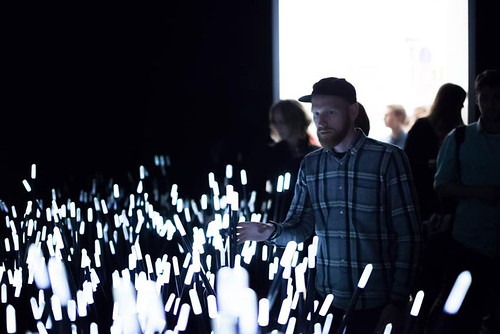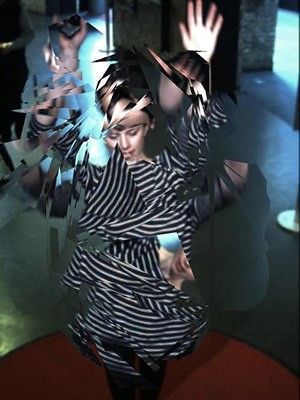Monday, 10:00am
2 September 2013
Tactile tendrils and funhouse therapy
‘Touch and Tweet!’ at Amsterdam’s Stedelijk encourages visitors to interact and leave their inhibitions behind

The Stedelijk Museum’s ‘Touch and tweet!’ exhibition in Amsterdam, featuring works by Daan Roosegaarde and Hellicar & Lewis, encourages visitors to interact with the installations, writes Sarah Snaith.
Studio Roosegarde, headed by creative director Daan Roosegarde, is a Dutch interaction design firm that has explores the relationships between ‘space, people and technology’. Roosegarde describes his work as ‘poetic monuments’, a fitting description of Dune (originally commissioned in 2007 and installed along the Maas river, Rotterdam), an energy-conscious ‘interactive landscape of light’ made of hard-wearing fibres, LEDs, sensors, speakers and interactive software. The piece, set inside an intimate corridor, is tactile, visual and auditory, and responds to the touch, movement and voices of passing visitors. Dune’s grass-like tendrils shiver in waves of light and sound and pleasingly clatter against one another when gentle touches grow wilder.
Daan Roosegarde, Dune, 2013. Photo: Tomek Whitfield.
Top: Photo: Tomek Whitfield.
Pete Hellicar and Joel Gethin Lewis, partners in London’s Hellicar & Lewis, create ‘fine art objects with the potential for commercial application’. Their work for clients such as Nokia (Nokia World, 2010) Coca-Cola (Coke 24hr Music, 2011) and Intel (Tryptch, 2012), allows them to pursue other open-source projects that benefit, among others, autistic children. ‘We’re a virtuous cancer within these corporations,’ said Lewis.
Feedback, in collaboration with Todd Vanderlin, was commissioned by London’s Roundhouse theatre and onedotzero for CircusFest 2010. Resembling funhouse mirrors, the installation shatters and distorts the viewer’s reflection.
Hellicar & Lewis, ‘Touch and tweet!’, Stedelijk Museum, Amsterdam. Documentary directed by Steven Elbers in collaboration with Diederick Huijbers, Todd Vanderlin, Marek Bereza and Dr Wendy Keay-Bright.
Somantics, an open-source application suite of ten apps (available for iPad and desktop or laptop computers connected to a Microsoft Kinect motion-sensor device), is the most compelling and playful of the three projects, in part for its intended audience. For those wanting to enrich the lives of children with autistic spectrum disorders, the application acts as a kind of physical therapy designed to encourage them to interact with the software and with other people. The screen-based applications react to their gestures, which become more significant with more people and more expressive movements.
The apps Sparkle, Windmill and Tunnel bathe the viewer’s reflected projection in colourful dots, set lines spinning into myriad shapes, and form a tunnel of geometric shapes that loosely resemble the body’s outermost edges. Standing in the exhibition, it isn’t difficult to see the power a design of this kind could have on a child’s life, not to mention the many museum visitors who experiment and interact with one another in its midst.
Stedelijk visitors enjoying ‘Touch and tweet!’.
Photo: Tomek Whitfield.
‘Touch and tweet!’ continues at the Stedelijk Museum, Amsterdam, until 8 September 2013.
Sarah Snaith, design writer and editor, London
Eye is the world’s most beautiful and collectable graphic design journal, published quarterly for professional designers, students and anyone interested in critical, informed writing about graphic design and visual culture. It is available from all good design bookshops and online at the Eye shop, where you can buy subscriptions, back issues and single copies of the latest issue.



